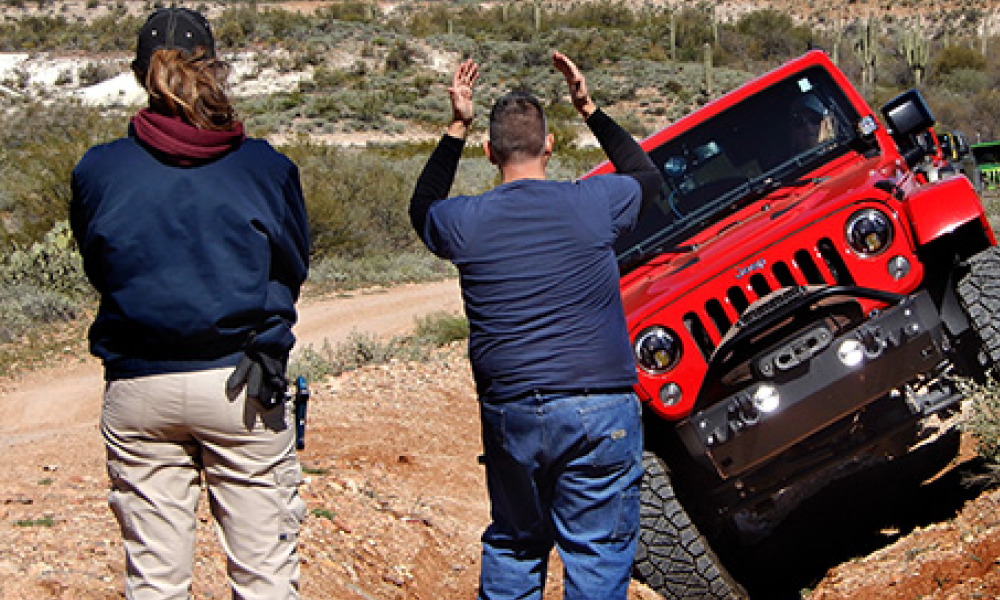Training 4wd Trainers
By Nena Barlow
In recent years, I have found that even more than teaching people the art and science of 4wd, I enjoy teaching people to teach other people the art and science of 4wd. It is so gratifying to help people stretch their comfort zone, and observe how differently we each learn.
One big distinction that many people aren’t clear on is the difference between a “guide” and a “trainer.” In brief, a guide chaperones guests through a trip, whereas a trainer teaches clients how to find their own way. While some of us enjoy both roles, and they aren’t necessarily mutually exclusive, it is necessary to understand the difference in the ultimate goal: Guides deliver a fun experience, Trainers teach skills.
Some Differences between “Guides” and “Trainers”
GUIDES
Spot guests through obstacles
TRAINERS
Coach clients to spot for each other and how to choose their own lines
GUIDES
Give history and context to the scenery, and set up routes to offer great viewpoints and surprise reveals
TRAINERS
Clearly explain the content and objective of each segment, why it is important, then execute the segment, and finally review and assess the execution of the segment.
GUIDES
Share stories and jokes
TRAINERS
Share sources of knowledge
GUIDES
Tell you what that button does
TRAINERS
Have clients work through the differences with and without the button and define its purpose for themselves
Overview of a Trainer Training Course with Barlow Adventures
Our goal as trainers is to impart to our students:
Safe and effective driving and recovery skills
Accurate and efficient navigation and trip conduct
Humble confidence and sustainable choices
Treading Lightly, giving back, helping the next generation
A good trainer can present on a variety of topics and adjust to a given audience, following the path of interests in the group. The best trainers know when to say “I am not sure about that–I will have to look into that and get back to you, or you may be able to find the answer here…”
But also consider this: Trainers need to think of themselves as not being the person in the room that has every answer to every question. They need to think of themselves as a resource directory to help their students find the information necessary to build their knowledge and skills to the next level. Students learn more by finding answers and conclusions themselves than they do from information being delivered to them as a speech.
Present appropriate topics clearly and implement engaging techniques for them to learn hands-on as much as possible. Ask yourself “How do I describe the mindset for the path we want them to explore?” or “How do I set the tone for them to ‘get’ this subject matter?” (Note: this is what I am trying to do right now for you!)
Explain what we are going to do and why (what is the objective of the lesson?)
Do it, repeat. (2-3 times, if time and space permit)
Talk about what you did. Self-assess, peer assess.
Provide honest feedback throughout the course. Help students develop their own honest self-assessment.
Establish a reasonable progression, building upon and relate to previous skills practiced and knowledge shared, whether from you in this class, or relating to other activities and experiences the students have. So many 4wd students come into this with other life experiences that can be applicable to a given situation from track racing to rock climbing to raising children.
Examine this list of training topics as part of a 4wd training curriculum, and think about and practice ways you can present these topics in an engaging manner. How can you make each of these topics a hands-on exercise for your students? What adjustments might you make mid-presentation if the audience is not “getting it” or not participating?
Proper seating - why, how
Loading, vehicle & equipment prep - i.e. airing down, COG, securing gear
Vehicle clearances and dynamics
Driver control finesse: throttle, brake, steering, and what the buttons and levers on different models do
Gear selection - effective and mechanically sympathetic decisions
Terrain analysis
Winching basics
Hi-lift safe operation
Rigging ropes, straps, shackles, and pulleys
Weaving Tread Lightly message into every activity
Ready to get out there? (Hint: you never feel 100% ready…do it anyway!)









